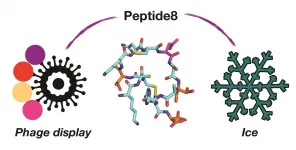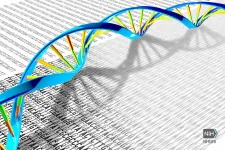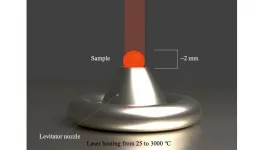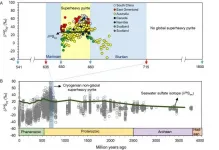(Press-News.org) Controlling, and mitigating the effects of ice growth is crucial to protect infrastructure, help preserve frozen cells and to enhance texture of frozen foods. An international collaboration of Warwick Scientists working with researchers from Switzerland have used a phage display platform to discover new, small, peptides which function like larger antifreeze proteins. This presents a route to new, easier to synthesise, cryoprotectants.Caption: Using viruses (phage display) to identify the one molecule in a billion (peptide8) that controls the formation of ice. Credit: University of Warwick
Ice binding proteins, which includes antifreeze proteins, are produced by a large range of species from fish, to insects to plants, to prevent the damage caused by ice. The proteins achieve the remarkable function of recognizing and binding to ice, even in the huge excess of water (which ice is the solid form of). New antifreeze proteins have typically been discovered by isolation from the organisms.
In this work, the team took a very different approach by screening billions of possible peptides to find those which could bind to ice. This was achieved by Phage Display - a technology whereby a virus is used to generate vast numbers of peptides, and those which 'bind' to the ice can be isolated.
Using this a cyclic peptide of just 14 amino acids (which is very short compared to a typical protein) was discovered which could bind to ice. The team used computer simulations to understand how the peptide binds to the ice, which is not possible by 'wet' experimental techniques alone. The team also showed how this short peptide can be used to help purified other proteins by ace affinity purification.
By identifying these short peptides, it means researchers can now simply make (or buy) modified peptides to understand and probe how these interact with ice and help design new cryoprotectants with simplified structures, and hence lower cost.
In the paper "A Minimalistic Cyclic Ice-Binding Peptide from Phage Display", published in Nature Communications the international team including the University of Warwick and led by EPFL, Switzerland, have demonstrated the use of phage display to discover new minimalistic antifreeze peptides, which could not be achieved by conventional tools, which would not allow the billions of potential structures to be screened.
Dr Gabriele Sosso, Assistant Professor at the University of Warwick, in the Department of Chemistry comments:
"This work highlights that even very small changes within the structure of these peptides can make a huge difference in their ability to control the formation of ice. Our computer simulations allowed us to identify and understand the importance of these structural changes - which is a key step toward the rational design of synthetic cryoprotectants.
"It is such a privilege to be able to leverage both the experimental work of the Gibson's group and the computational resources of the SCRTP. Truly, Warwick is a great place to be if you want to understand how ice forms and what can we do to have a say in this process."
Professor Matthew Gibson, Professor at the University of Warwick in the Department of Chemistry and Warwick Medical School adds:
"We have been working on developing synthetic tools to understand, and interfere with, ice growth processes with an aim of helping develop new cryoprotectants. This work was really exciting, as we made use of biotechnology tools (phage) to discover small, cyclic, peptides which are remarkably potent.
"These peptides are easy to synthesis and modify and will accelerate our research in this field. It also highlights the growing 'team ice' collaborative network at Warwick, combining experimental and computation studies together. We are also grateful for the support from the IAS at Warwick, which allowed Dr Stevens to visit us to complete this work, showing the need to support international scientific collaborations."
INFORMATION:
NOTES TO EDITORS
The research and development of this has been supported by the European Research Council (638661), EPSRC (EP/P020232/1, EP/R029407/1) the Swiss Science Foundation and the Institute of Advanced Study at the University of Warwick thanks to a Fernades Fellowship.
High-res images available at:
https://warwick.ac.uk/services/communications/medialibrary/images/april_2021/gibson.sosso_crop.jpg
Caption: Using viruses (phage display) to identify the one molecule in a billion (peptide8) that controls the formation of ice.
Credit: University of Warwick
For further information please contact:
Alice Scott
Media Relations Manager - Science
University of Warwick
Tel: +44 (0) 7920 531 221
E-mail: alice.j.scott@warwick.ac.uk
An investigational gene therapy can safely restore the immune systems of infants and children who have a rare, life-threatening inherited immunodeficiency disorder, according to research supported in part by the National Institutes of Health. The researchers found that 48 of 50 children who received the gene therapy retained their replenished immune system function two to three years later and did not require additional treatments for their condition, known as severe combined immunodeficiency due to adenosine deaminase deficiency, or ADA-SCID. The findings were published today in the New England Journal of Medicine.
ADA-SCID, ...
Low doses of a four-drug combination helps prevent the spread of cancer in mice without triggering drug resistance or recurrence, shows a study published today in eLife.
The findings suggest a new approach to preventing cancer metastasis in patients by simultaneously targeting multiple pathways within a metastasis-promoting network. They may also help identify people who would most likely benefit from such treatment.
Metastasis, the spread of cancerous cells through the body, is a common cause of cancer-related deaths. Current approaches to treating metastatic cancer have focused on high doses of individual drugs or drug combinations to hinder pathways that promote the spread of cancer cells. But these approaches can be toxic to the patient, and may inadvertently activate other pathways ...
A new study from the University of Chicago has found that the photosynthetic bacterium Synechococcus elongatus uses a circadian clock to precisely time DNA replication, and that interrupting this circadian rhythm prevents replication from completing and leaves chromosomes unfinished overnight. The results, published online on May 10 in Proceedings of the National Academy of the Sciences, have implications for understanding how interrupted circadian rhythms can impact human health.
Circadian rhythms are the internal 24-hour clock possessed by most organisms on earth, regulating ...
Argonne scientists across several disciplines have combined forces to create a new process for testing and predicting the effects of high temperatures on refractory oxides.
Cast iron melts at around 1,200 degrees Celsius. Stainless steel melts at around 1,520 degrees Celsius. If you want to shape these materials into everyday objects, like the skillet in your kitchen or the surgical tools used by doctors, it stands to reason that you would need to create furnaces and molds out of something that can withstand even these extreme temperatures.
That's where refractory oxides come in. These ceramic materials can stand up to blistering heat and retain their shape, which makes them useful for all kinds of things, from kilns ...
May 11, 2021 - Like other medical specialties at the start of the COVID-19 pandemic, orthopaedic surgery rapidly pivoted from in-person visits to remote appointments via telemedicine. Analysis of that initial experience finds that some groups of patients faced persistent or worsening disparities as the shift to telemedicine occurred, reports Clinical Orthopaedics and Related Research® (CORR®), a publication of The Association of Bone and Joint Surgeons®. The journal is published in the Lippincott portfolio by Wolters Kluwer.
"We found concerning disparities in access ...
TAMPA, Fla. - A hallmark of cancer is its ability to evade the immune system. It is why researchers are focused on finding new strategies and targets to jumpstart the immune system so it can mount a response against tumors. One such target is the inhibitory receptor T-cell immunoglobulin and mucin domain 3 (TIM-3), a protein that is overexpressed in many different types of cancer and is associated with poor patient outcomes. It is known to block the activity of immune cells, such as dendritic cells, but how remains unclear. In a new article published in the journal Immunity, Moffitt Cancer Center researchers show that TIM-3 inhibits the STING signaling pathway in dendritic cells, thereby blocking their ability to elicit an immune response.
Dysregulation ...
Point:
Novel chiral diacid monomers were synthesized.
Chirally interactive BioNylons were prepared.
BioNylon showed thermal/mechanical performances than conventional Nylons.
BioNylons disintegrated and degraded with pepsin.
Summary:
Marine plastic waste problems have been more serious year by year. One of the worst issues is that creatures in ocean are going extinct by mistakenly swallowing them.. Conventional biodegradable plastics are degradable in digestive enzymes, but their performances are too low to use in society. In this study, researchers from JAIST have used bio-derived resources such as itaconic acid and amino acid for the syntheses of high-performance BioNylons having the pepsin degradation function.
Ishikawa, ...
Quantum mechanics can be used to create more stable and more easily produced organic solar cells. These are the findings of new research from the University of Gothenburg.
Organic solar cells have many advantages compared with traditional silicon-based solar cells. They can be manufactured cheaply at a large scale using printing presses, and they are light, malleable and flexible. The problem is that today's organic solar cells are not as stable and effective as silicon-based solar cells. In a new study, a research group has taken on this problem and found a way that can lead to more cost-effective solar cell technology.
"There are excellent opportunities for utilising quantum efficiencies to change different chemical ...
The Sturtian Snowball Earth glaciation (717~660 million years ago) represents the most severe icehouse climate in Earth's history. Geological evidence indicates that, during this glaciation, ice sheets extended to low latitudes, and model simulations suggest global frozen ocean as well as a prolonged shut-down of the hydrological cycles. The Snowball Earth hypothesis poses that the Sturtian global glaciation is directly triggered by intense continental weathering that scavenges atmospheric CO2, while the global frozen condition is terminated by ...
One of the most basic structural aspects of relativistic spacetime is the description of how time and distances are altered by motion. The theory of special relativity describes a spacetime framework for linear constant motion in which time dilates and lengths contract in response to motion. This framework is described by the Lorentz transformation, which encompasses mathematical formulas that describe how time and distance are altered between moving reference frames. The Lorentz transformation also describes how a stationary observer views time in the moving frame to be offset with distance. ...





